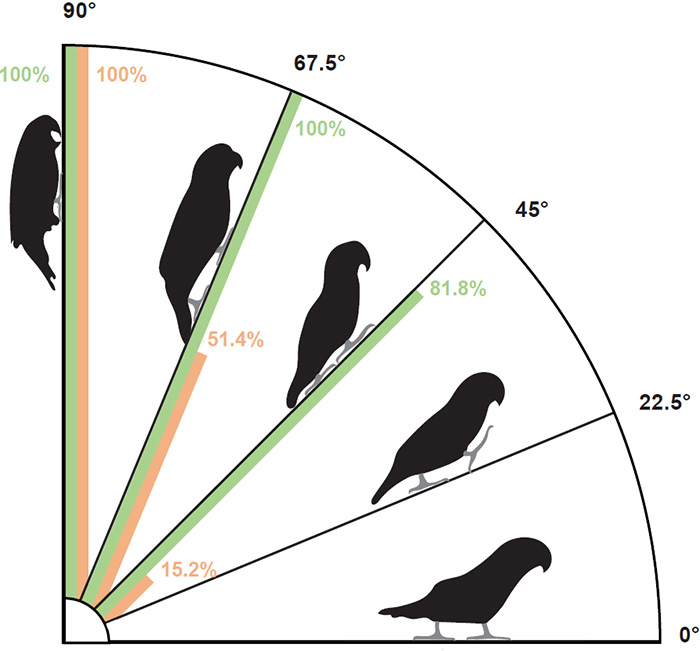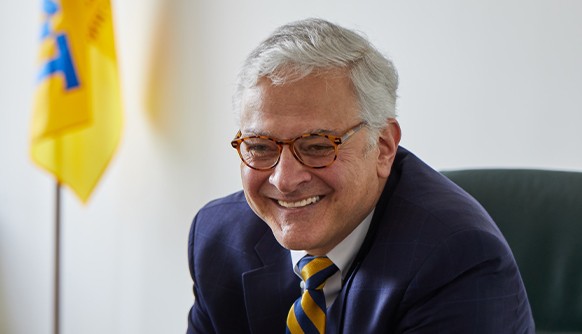News
Polly Want to Climb?
May 18, 2022
No vertebrate (fish, mammal, bird, reptile, or amphibian) has ever had an odd number of limbs. Despite this “forbidden phenotype,” some animals seem to use other body parts as a third or fifth “limb” to move from one place to another.
For example, while parrots are unable to use their wings for grasping, they climb by extending their heads and grasping branches or other surfaces with their beaks. It is unclear, however, whether the head acts as a “third limb” that propels the bird or if it is simply used for stabilization, with the beak hooking into surfaces for support.
Now, for the first time, research from the College of Osteopathic Medicine (NYITCOM) finds that parrots do, in fact, use their head as a propulsive third limb. A new study in the journal Proceedings of the Royal Society B, authored by medical student Melody Young and Michael Granatosky, Ph.D., assistant professor of anatomy, and Post Doctoral Fellow Edwin Dickinson, Ph.D. analyzed the climbing gaits of rosy-faced lovebirds (Agapornis roseicollis), a species of small parrot.
The researchers devised a series of experiments in which the parrots climbed a man-made vertical runway positioned at angles ranging from zero to 90 degrees. Two high-speed cameras captured their movement, while a small force plate mounted to the back of the runway measured the force generated by the beak, hindlimbs, and tail as each body part came into contact with the runway.

The parrots’ beaks first contacted the vertical runway when climbing at a 45-degree angle and, then consistently made contact while climbing at a 90-degree angle.
The parrots’ beaks first contacted the runway when climbing at a 45-degree angle and, when climbing at a 90-degree angle, generated forces that were comparable to those produced by the hindlimbs. In fact, the forces generated by the parrots’ beaks were of equal or greater magnitudes than the forces known to be produced by the limbs of humans or other large primates during climbing. In contrast, the birds’ tails produced minimal forces, suggesting that the tail is used simply for support and not as an additional limb.
Young, who is enrolled in NYITCOM’s Osteopathic Medicine, D.O./Medical & Biological Sciences, Ph.D. program, notes that the anatomy of parrots likely evolved over many years to support these resourceful climbing behaviors.
“Although many birds climb vertically, so far, parrots are the only birds known to engage the head as a third limb. This behavior seems to have necessitated neuromuscular changes over time, including neck flexors that generate additional force and modifications to spinal neural circuitry,” she said.
A rosy-faced lovebird climbs the vertical runway at a 90-degree angle by extending its neck and grasping the runway with its beak. As shown in the video’s graphs, forces produced by the beak were comparable to those produced by the hindlimbs, suggesting that the head serves as a third “limb” during climbing.
Granatosky, who is an expert in the evolution of animal movement (locomotion), suggests that parrots’ innovative climbing behavior may distinguish them from other animals as well.
“While juvenile pandas are known to swing their heads laterally as they ascend vertical surfaces, appearing to use their head as a ‘fifth limb,’ it does not make contact with the surface. Utilizing the head as a propulsive limb represents an evolutionary novelty that, to our knowledge, has only ever existed in parrots,” said Granatosky. “We hope our findings will enhance our understanding of how animals co-opt unusual anatomical structures to adopt entirely novel behaviors.”
This project is the first step in a series of studies focused on the locomotor behaviors of parrots. Parrots are an ancient arboreal (tree-dwelling) lineage with many behavioral and anatomical parallels to living primates. While many studies have highlighted parrots’ incredible intelligence, research on their locomotor behavior is almost nonexistent. Over the next few years, Granatosky and his lab will work to understand the anatomical and neuromuscular underpinnings of parrots’ unusual locomotor behaviors to develop bio-inspired robotic systems that simulate this movement.





